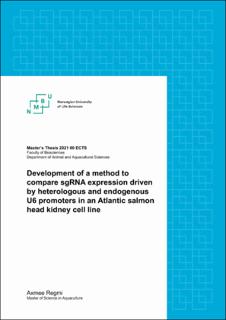| dc.description.abstract | Infectious diseases have negative impacts on fish welfare and sustainable aquaculture. Knowledge on host pathogen relationship and genes responsible for disease resistance could lead to development of vaccines and therapeutics and other potential commercial applications. The application of CRISPR/Cas9 methods like genome-scale CRISPR knock-out screening (GeCKO screening) has great potential in identification of functional genes for a particular trait. However, application of CRISPR in fish cell lines is still in its infancy and has several limitations. In CRISPR screens, expression of sgRNA, one of the important components of the CRISPR/Cas9 method, is driven by a U6 promoter situated in a lentiviral vector. For the success of the CRISPR screen, it is crucial that the U6 promoter is efficient in the cell line used. This has never been tested in any Atlantic salmon cell line before. The aim of this thesis was to test the efficiency of different U6 promoters – human, mouse, zebrafish, and novel uncharacterised salmon U6 promoter in the Atlantic salmon cell line, SHK-1 (Salmon head kidney-1). This was done with a sgRNA expression assay. In short, 4 different U6 promoters and GFP knockout gRNA were cloned into a single lentiviral vector system. The plasmids generated were then transfected into SHK-1 cells with electroporation. After two days, total RNA from the cells was isolated and used for cDNA synthesis. Finally, the transcription of sgRNA under each promoter was compared using qPCR. Since this has never been done before, and the methods used was new in our lab, this thesis involved a lot of method development and optimization. Due to technical difficulties and Covid-19 restrictions, I had only time to perform one single biological replicate in the SHK-1 cell line with the partially optimized protocol. I was able to demonstrate that one of the plasmids that we designed was able to express sgRNA
under zebrafish U6 promoter. Although the expression level was low, it was a huge success for us as it showed overall success of plasmid design, transfection of cells, primer validation, and qPCR assay optimization. One of the major findings in this thesis is that it is crucial to digest DNA in the sample before qPCR, since we use a large amount of DNA for transfection. This thesis describes and discuss the development and optimization of a method for determining U6 promoter efficiency using a sgRNA expression assay with qPCR, from construction of vectors to optimization and analysis of the qPCR experiment. The methods optimized in this thesis can be used to assess the efficiency of multiple U6 promoters in different cell lines in the future. | en_US |

